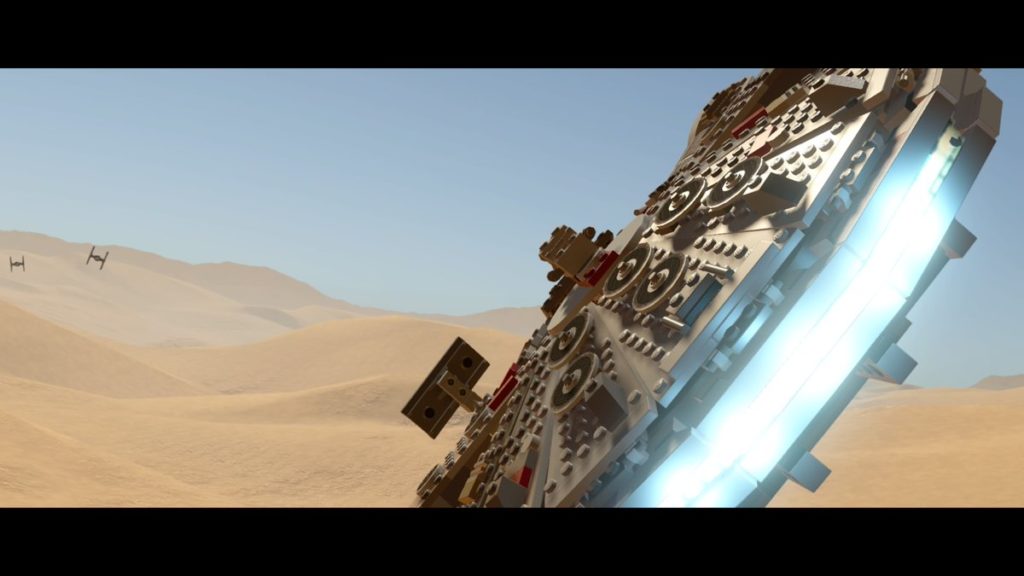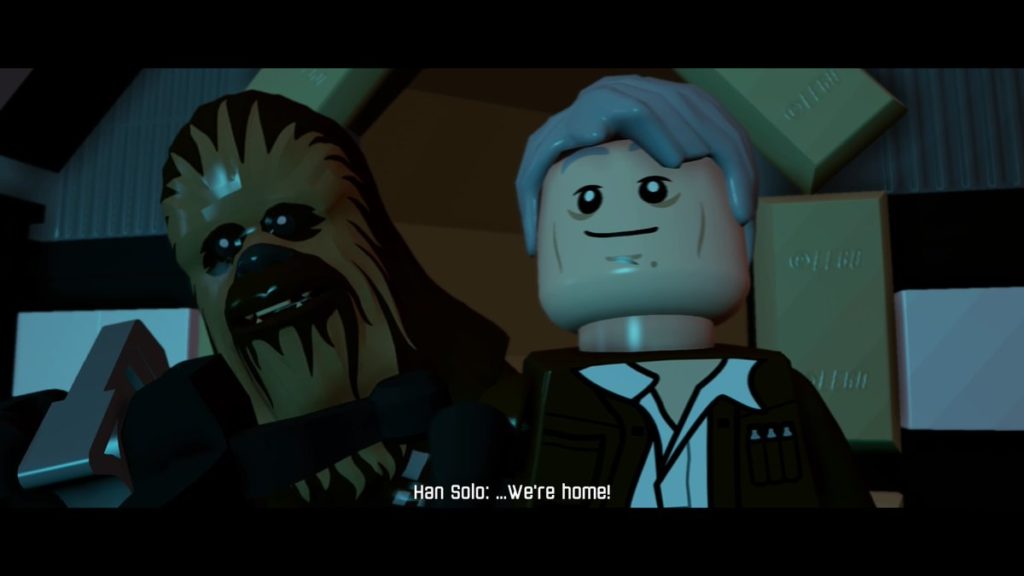Lego Star Wars: The Force Awakens review: Built without instructions
Reaching into its 11th year, the Lego Star Wars series has finally added the most recent film, The Force Awakens, into its plastic, half-bent arms. And I'm not sure if it's for the better. Lego Star War: The Force Awakens releases with the notion that much from the original formula has changed, and while much of that is true, many of the changes feel more like clawing desperation to innovate rather than developer TT Fusion feeling the need to shake things up. It's like Warner Bros. felt that if TT Fusion left things the same, but just put it inside The Force Awakens, they'd pull out the newspaper and start whacking the developer's hands until they typed innovation into the code or something.Lego Star Wars: The Force Awakens starts off with a sort of tutorial mission based on the assault on the Death Star 2 from Return of the Jedi. The mission itself is a great way to show off some of the new mechanics they've added, even if their implementation is a bit off. The first thing those that have played prior Lego Star Wars games will notice is that characters are now voice acted. Cut-scenes are now the actors saying the lines they said in the movie, just about verbatim. Or it might even just be the audio from the movie lifted and placed into the game for all I know.

Reaching into its 11th year, the Lego Star Wars series has finally added the most recent film, The Force Awakens, into its plastic, half-bent arms. And I’m not sure if it’s for the better. Lego Star War: The Force Awakens releases with the notion that much from the original formula has changed, and while much of that is true, many of the changes feel more like clawing desperation to innovate rather than developer TT Fusion feeling the need to shake things up. It’s like Warner Bros. felt that if TT Fusion left things the same, but just put it inside The Force Awakens, they’d pull out the newspaper and start whacking the developer’s hands until they typed innovation into the code or something.
Lego Star Wars: The Force Awakens starts off with a sort of tutorial mission based on the assault on the Death Star 2 from Return of the Jedi. The mission itself is a great way to show off some of the new mechanics they’ve added, even if their implementation is a bit off. The first thing those that have played prior Lego Star Wars games will notice is that characters are now voice acted. Cut-scenes are now the actors saying the lines they said in the movie, just about verbatim. Or it might even just be the audio from the movie lifted and placed into the game for all I know.
Much of the fun of the Lego Star Wars series is the way the plot is doled out. The basic stories of Star Wars are pretty common knowledge, and The Force Awakens is definitely no exception with how large of a crowd it drew this past holiday season. In prior games, the Lego figures would display basic emotions by gesturing like a wacky, waving inflatable arm man instead of using lines from the movies. The players all knew what was happening, but seeing these little Lego figurines gesture the plot like seizure-prone mimes in a sensory room made it all the more enjoyable.

Lego Star Wars: The Force Awakens adds full voice acting, which makes everything feel more serious. Besides a few random visual jokes, most of which were just Stormtroopers in beach wear or fitness gear, this is more akin to a movie game, but with Lego figures replacing high-detail models and environments. It makes the entirety of the plot feel like the local elementary school is putting on a sock puppet performance of the film rather than a Lego Star Wars game.
For the most part, combat’s stayed the same. Aim your character, press the shoot or stab button, and they’ll be somewhat reliable on hitting the intended target. Lego Star Wars: The Force Awakens does add in some cover-based shooting sections, but they almost feel like mini-games in between each level rather than pieces of the level itself. Each cover-based shooting section has the player kill a certain number of enemy troops, as well as a turret, building, or vehicle, and the controls don’t exactly seem to function well. Multiple times, my character would fail to swap between two sets of walls or would have problems being able to aim at the object he needed to shoot.
Surprisingly, the vehicle combat, mainly aircraft, feels exciting and invigorating. These sections actually feel like interesting and tense air battles. I’d say they even hold better pacing than Battlefront’s “Fighter Squadron” mode. The game does auto-invert the controls, though, meaning the handling can take a second to figure out. Once I figured that out and flipped them back, the air combat flowed quite nicely, and served as the more memorable part of the game.
Another new feature is the ability to have multiple builds. In prior Lego games, players use some of the Lego bricks from destroyed objects to build whatever it is they need to hurdle an obstacle. These Lego piles can now be used to make different builds rather than one set of Lego blocks only building one object. Sometimes, this means using the same pieces to complete a multi-step puzzle, while other times this means using a secondary build to find secrets hidden in the game. Most of the time, the feature feels a bit phoned-in, since it’s hard to determine what the end-product will function as. The logic of some of the devices almost feels like 80’s adventure game logic, where you’d need to throw a bridle on a snake blocking a path to turn it into a horse.
The game’s stuffed with over 200 playable characters, which makes it a bit of a pain. There’s just way too many unneeded characters to sift through. I could see why they might want to add different costumes for Han Solo or Leia, with both characters being in a variety of situations and in a variety of different looks. But characters like the memorable Gaff Kaylek or that awesome dude Hobin Carsamba were probably best left out. The character sheet has more bubbles than a standardized test, and finding which character you’re looking to play as is a pain to scroll through.
One thing that is somewhat minor, but really awesome, is the way split-screen plays out. Rather than just dividing the screen straight through the middle, it did this sort of angle-split sometimes that would spin around and combine when both players were in the same area. It’s hard to explain, so check out this YouTube video that shows some of it in action. But it feels very Star Wars-esque, for lack of a better adjective, and both looks awesome and transitions well while two players are playing.
There’s also a variety of side-missions to complete, which I didn’t really have a desire to complete. I tried out three, but only managed to care to complete one of them, which is Poe Dameron rescuing Admiral Akbar from the Imperials in an almost scene-for-scene replication of rescuing Princess Leia in A New Hope. The one cool thing you get from it is unlocking Admiral Akbar as a playable character, but many of these side missions feel like filler for a short story mode. From start to finish, the game took me a day and a half to finish the story mode, so maybe there’s way more to those side missions than the three I played. Maybe I just happened to pick the three worse ones. But the game never offers much incentive to play them other than ‘why not?’ which is the same logic I’d utilize when doing most things I later regret doing.
The Lego Star Wars series was always a game series that raised the bar for children’s games, creating games that were fun for both kids and adults alike. With Lego Star Wars: The Force Awakens, there feels like there’s definitely been an awakening. But rather than an awakening to some creative idea or passionate project, it feels like investor’s alarm clocks woke them to the huge popularity of The Force Awakens and attempted to shoot out a version of the movie done in Lego six months after the film released. Rather than feeling like a proper Lego Star Wars entry, Lego Star Wars: The Force Awakens feels like cheap plastic.
